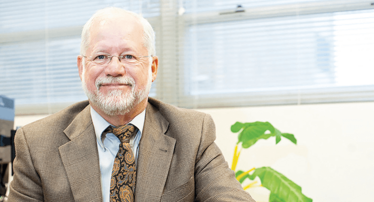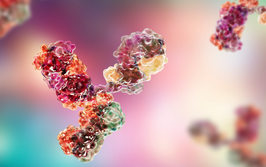Holistic Bioanalytics in the Clinic
Lawrence (Larry) Lesko is a bioanalytical veteran with many years of academic and FDA experience under his belt. Now, as director of the University of Florida’s Center for Pharmacometrics and Systems Pharmacology, Larry uses metabolomics to discover biomarkers of drug toxicity.
sponsored by Agilent

Larry became a chemist (and the first scientist in the family) at the age of seven with a Christmas gift that fired a growing interest in magic rocks, rockets and (by today’s standards) dangerous chemical reactions. At high school, Larry’s lifelong interest in pharmaceuticals began with a part-time job at the local pharmacy, where he was tasked with drug compounding, learning about solutions and precipitation as he went – essentially, a continuation of his childhood chemistry set experience...
So, when did the serious academic learning begin?
I applied for – and received – a five-year scholarship at Temple University’s School of Pharmacy from the Pennsylvania state senator. My dad was a former coal miner and my mum worked in a factory, so it really was the only option for me to get ahead. Pharmacy school seemed to be the natural choice – and I enjoyed it, but I realized that I wouldn’t actually have the opportunity to practice much science if I continued down that path. In particular, I had become very interested in the scientific process of drug development. I recognized I needed an advanced degree to get into that field, so went back to graduate school and did summer internships at a couple of pharmaceutical companies. I worked at Roche in New Jersey and Wyeth Laboratories in Philadelphia and got exposed to many aspects of pharmaceutical development – including mass spectrometry and other analytical methodologies.
And so you chose to go into industry after your PhD?
Actually, after weighing up my options, I decided to go into academia. I interviewed for a position at Texas Southern University, which was looking to improve pharmacy graduation rates. They offered me an intellectual challenge (or opportunity) that I couldn’t resist, and they asked me to start a graduate research program, which sealed the deal. I succeeded in both areas – and set up an analytical laboratory – before moving up to the University of Maryland in Baltimore to become director of the Pfeiffer Clinical Pharmacokinetics Research Laboratory and an associate professor of pharmacy. A couple of years later, I found myself the director of what was essentially a fully-loaded analytical service laboratory.
Was there a common theme driving your many career moves?
Looking back, I was passionate about building successful entities – whether an analytical lab or a graduate program. My next move was to the University of Massachusetts Medical Center (director of its Clinical Pharmacokinetics Laboratory) and then onto a company called PharmaKinetics Laboratories, where I was vice-president of the Analytical Laboratory Services Division. We did contract work for the pharmaceutical industry and I headed up bioanalytical method development and validation – and that’s where I really got into mass spectrometry. In the contract world, you’re always competing with other laboratories, so you have to stay at the cutting edge in terms of sensitivity. I hired a mass spectrometer specialist to run the mass spec lab and develop assays. It really was the analytical big time! We ran three shifts of analytical chemists – a real 24/7 analytical factory – to maintain the high throughput needed for industry customers.
And then you spent nearly 20 years at the FDA...
That’s right. I knew a couple of well-known leaders in the FDA – Carl Peck (Director of CDER) and Roger Williams (Director of the Office of Generic Drugs – OGD), and they invited me to take up a new position, developing a new research program in cOGD. I joined the FDA in 1992 as director of research at OGD down in Rockville, Maryland. The position required a very broad-based view of analytics; the research revolved around finding new clinical and analytical methodologies to show bioequivalence of generic products in challenging areas (topical creams or inhalable medicines, for example). In 1995, the FDA opened the Office of Clinical Pharmacology and Biopharmaceutics – and I was asked to become the director and build the office from the ground up. We started with 20 people and I left in 2011 when we had nearly 180.
What were your main highlights at the FDA?
We developed guidance for industry on bioanalytical method development and validation, which is the state of the art today. Another highlight was getting involved with personalized medicine in 2002. I was asked to look at approved drugs and determine in which cases genomics could be introduced into the label. We updated the labels of around 15 important drugs in that nine-year period. Perhaps more revolutionary was the Voluntary Genomics Data Submission Program that we started. We felt that the pharmaceutical industry was not sharing the work they were doing in pharmacogenomics with the FDA – so we created a “safe harbor.” Companies could submit data for advice rather than for review, preparing them (and us) for the future. We received around 100 voluntary submissions, which got our internal staff up the learning curve very quickly. Often, there is a perception that regulatory agencies are followers and unlikely to adopt new science readily – I really wanted to change that perception and enable the FDA to lead the field.
You were also involved in the Critical Path Initiative.
Correct. One of the goals was to introduce innovations into drug development. One of the innovations I led was model-based drug development, which used quantitative methodologies, bioinformatics and in silico studies to design and model clinical trials and reduce the regulatory burden for pharma companies. We started the Division of Pharmacometrics in 2008, which was responsible for assessing companies’ modeling and simulation data.
How did you end up back in academia?
Well, that story is relevant to my current use of mass spectrometry. In 2010, I got interested in innovations related to drug safety – a paradigm that hadn’t shifted in about 40 years. Safety evaluations tended to be retrospective; that is, companies put a drug through a clinical trial or introduced it into the marketplace, and only then recognized an adverse event. I wondered, why do we react rather than predict? A question that led to my interest in integrated systems biology. I started the Mechanistic Drug Safety Program at FDA, which used software and analytical methodologies to investigate drug–adverse event pairs. For example, if you took a drug and had a skin reaction, we would use bioinformatics approaches to track the event back to a drug mechanism. Therefore, we could explain adverse events and use the information gained to predict potential adverse events for new drugs. The program is now used in the review of new drug applications (NDAs) for safety. Anyway, I moved to the University of Florida in 2011 and became the director of the Center for Pharmacometrics and Systems Pharmacology.
I wanted to continue my work on drug safety, so we purchased two Agilent LC-MS systems. One was a triple quadrupole MS (the Agilent 6460 QQQ) for targeted metabolomics to enable the study of biomarkers at the cellular level and use them as a signature of a drug–toxic event relationship. And we needed the second system – a time-of-flight MS (the Agilent 6550 LC qTOF) – for global metabolomics to identify new biomarkers of drug toxicity.
Yusuke Tanigawara at Keio University in Tokyo was studying the metabolomics of anti-cancer drugs from a therapeutic mechanisms perspective; I spent a week in his laboratory and was very impressed by his LC-MS instrumentation. And next door to us is the Sanford-Burnham Medical Research Institute – I also gained some recommendations from the scientists there on which models I should be looking at to match my needs; sensitivity is a huge driver for us, and given my long history of managing analytical labs, I also wanted efficiency – and that means robust instrumentation with little-to-no downtime. Notably, the Agilent systems are pretty kind to new users, and it was relatively easy to transfer assays from the literature. More importantly, the Agilent support team was always on hand should the need arise.
Can you share specific projects your working on?
Right now there are two main projects. One is a study of drug-induced kidney damage; can the metabolome act as a “reporter” of toxicity ahead of a clinical laboratory test for serum creatinine (which only highlights a problem after 50 percent of the damage has already occurred)? If we can predict renal damage earlier, we can change the drug or drug dosage or introduce extra fluids and improve the patient’s future quality of life. It’s really an important unmet medical need. We’ve started out with a serious candidate that causes toxicity – the chemotherapy drug, cisplatin – which has an adverse event rate for renal damage as high as 35 percent for cancer patients in intensive care (around 7-10 percent for other patients). That’s a lot of people with kidney damage. We obviously want to move onto other nephrotoxic drugs as the project moves forward; one of the interesting research questions is whether or not the metabolomic signature for cisplatin is drug specific or applicable to other drugs that can cause kidney damage.
The other project is focused on a rare and serious skin disease called Stevens-Johnson syndrome (SJS), which affects about one in 10,000 people (but has a much higher rate in Asian populations). A common drug that causes it is acetaminophen (or paracetamol) and we wanted to figure out the mechanism behind it. I’m happy to report that we have uncovered the pharmacological mechanism and also how to reduce its risk by using a protective agent. We’re writing that up for publication at the moment.
How do you see your research ultimately being applied?
The end game is to employ integrated models that use biomarkers from metabolomics and so-called patient co-variates (like age, race, sex) to inform clinical decisions. For example, in the case of cisplatin, we might look at changes in a metabolomic profile based on 25–50 biomarkers and use that information to offer clinical options; for example, reducing the dose by half (since the patient still needs the drug) or minimizing toxicity by giving a concomitant medication that would block toxicity-causing pathways.
Your work on metabolomics appears more applied than most...
If you look at the broader world of metabolomics, it’s very technology focused. A great deal of emphasis gets placed on the minutia of the analytical methods – and there’s nothing wrong with that; it’s important to drive the technical aspects of the field forward. It’s a very similar scenario in personalized medicine, where half a conference can be devoted to next-gen sequencing and other technology. But the people at the technology end are not often clinically oriented. In many ways, I would say that technology has raced ahead of application in all the omics. We have the technology we need – let’s put it to good use. As a clinical professor, I want to convert information from these new tools into valuable knowledge that can have a positive clinical impact – something I am very passionate about.



















